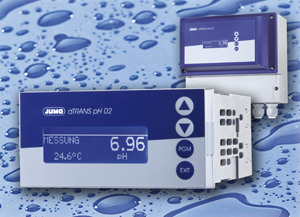Mettler Toledo Safeline has made a significant breakthrough in the detection of contaminants in fluids with the launch of the new FluidCheK x-ray inspection system. Developed primarily to meet the needs of manufacturers and packers of beverages and other liquids, this efficient system is equipped with advanced image-scanning software and employs x-ray beams at an angle for total quality control.
Thermo Fisher Scientific Inc. announced the launch of the Thermo Scientific EQuan MAX, an automated high throughput Liquid Chromatography-Mass Spectrometry (LC-MS) solution for the analysis of contaminants in water and beverages. This innovative system with high resolution and accurate mass (HRAM) boasts new screening and quantitative capabilities that provide enhanced system flexibility and productivity.
This new development was intended to take the place of the successful and internationally established first dTRANS …01 series. With extended functions in the same compact housing, the JUMO dTRANS pH/CR/AS/Ci 02 instrument series now covers all the measurement variables. The mounting dimensions for the panel-mounting instruments are 96 mm x 48 mm x 90 mm (W x H x D) and these instruments are also available in a surface-mounted housing, with IP 67 protection.
GEMÜ has developed new stainless steel ball valves in the nominal sizes DN 8 – 100. The new GEMÜ 740 series has been specially designed for demanding applications in the pharmaceutical and foodstuff industry.
Baumer’s digital pressure switch series TED is now available with several 3A-approved process connections. Therefore, the hygienic measuring instrument is especially suitable for applications in the food and beverage and pharmaceutical industries.
Bürkert Fluid Control Systems has enhanced the technical features and appearance of its digital flow transmitters. The models 8026, 8036 and 8076 now shine in the consistent stainless steel design of the ELEMENT series. New processors, new software, additional features and an innovative operating concept distinguish the next generation of these successful Bürkert transmitters.
For hygienic pressure measurement, Baumer offers the electrical pressure transmitter ED701. It is especially suitable for applications in the pharmaceutical and food & beverage industries as well as in medical technology. The measuring device features high accuracy and long-term stability. It is available with several Clamp and hygienic process connections.
Kvass or kvas, is a traditional beverage primarily known in Russia, the Baltic States and the Ukraine, where it is predominantly consumed during the summer months. The ingredients and recipes are diverse, because kvass production was for centuries a cottage industry; that is, it was brewed by families at home. Each family possessed their own recipe for brewing kvass using a wide range of ingredients; however, one ingredient common to all of them is rye. For kvass made at home, the rye was first baked into loaves of bread before commencing the brewing process [1]. For industrial production, it was necessary to find other raw materials, such as raw grain, sugar and various types of malt. The following report offers an overview of the ingredients and processes and also outlines the possible methods by which kvass can be produced on an industrial scale.
With the InPro 6970i series, Mettler-Toledo Ingold introduced a new line of optical sensors for the measurement of dissolved oxygen in Food & Beverage. Based on a chemo-optical technology, the InPro 6970i sensor offers significant advantages for the brewing industry. High operational availability, combined with excellent measurement quality is the perfect answer to the most demanding brewery requirements such as increased product yield and guaranteed minimized level of oxygen in beer.
The problem of nitrosodimethylamine (NDMA) confronted the industry in January of 2006, because analysis results showed that certain malt samples had exceeded the recommended maximum concentrations for NDMA, once again returning this topic to the spotlight. Monitoring systems commissioned by the German Maltsters’ Association as well as the German Brewers’ Association have been in place since the middle of 2005, which are intended to screen malt – especially malt sold on the market – for its NDMA content. Preventing the formation of NDMA is important, not only from the standpoint of the legal guidelines governing its maximum allowable content but also due to the significant danger of attracting negative media attention, since nitrosamines are both carcinogenic and very soluble in water. Nitrosamines readily pass through cell membranes and, if ingested, increase the risk of cancer in almost every organ in the body. NDMA formation occurs during the kilning process. The amines (e.g. hordenine) naturally present in malt and the nitrogen oxides from the air intermingle under application of heat to form NDMA.
The first Westfalia Separator hydrostop separator – a clarifier type SC 35 – was delivered to the Bavik brewery in Bavikvove, Belgium in 1984. The next major step followed in 1990: The SC 120 was the first machine capable of performing ejections every 45 seconds.









